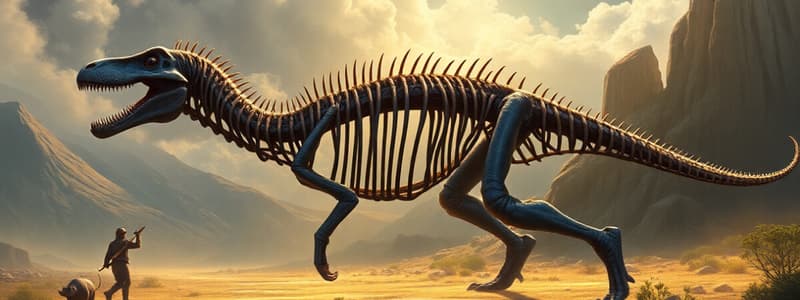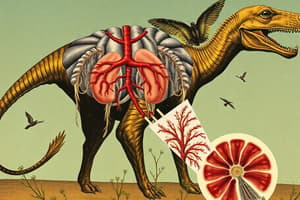Podcast
Questions and Answers
The 'Age of the Fishes' is associated with which period(s)?
The 'Age of the Fishes' is associated with which period(s)?
- Tertiary, Quaternary
- Permian, Triassic, Jurassic
- Pleistocene, Holocene
- Ordovician, Silurian, Devonian (correct)
Which of these organisms is considered an invertebrate that possessed a notochord?
Which of these organisms is considered an invertebrate that possessed a notochord?
- Haikouella
- Pikaia (correct)
- Hagfish
- Conodont
What is a key characteristic that Haikouella possessed, indicating it was not a true vertebrate?
What is a key characteristic that Haikouella possessed, indicating it was not a true vertebrate?
- Presence of a notochord
- Presence of myomeres
- Absence of a cranium (correct)
- Presence of pharyngeal muscles
During which geological period did the genus Homo first appear?
During which geological period did the genus Homo first appear?
What synapomorphy is NOT considered a characteristic of vertebrates, found in the early fossil record?
What synapomorphy is NOT considered a characteristic of vertebrates, found in the early fossil record?
What evidence suggests a marine origin for the earliest vertebrates?
What evidence suggests a marine origin for the earliest vertebrates?
Which of the following is the correct order from oldest to newest, regarding the geological periods mentioned in the text?
Which of the following is the correct order from oldest to newest, regarding the geological periods mentioned in the text?
What was a significant discovery about Conodonts that helped clarify their place in the fossil record?
What was a significant discovery about Conodonts that helped clarify their place in the fossil record?
Which of the following is NOT a characteristic of cyclostomes?
Which of the following is NOT a characteristic of cyclostomes?
What is the primary feeding strategy of adult parasitic lampreys?
What is the primary feeding strategy of adult parasitic lampreys?
How do hagfish differ from lampreys regarding their gill openings?
How do hagfish differ from lampreys regarding their gill openings?
What ventilatory method do larval lampreys utilize for respiration?
What ventilatory method do larval lampreys utilize for respiration?
What does the term 'anadromous' describe in the context of the lamprey life cycle?
What does the term 'anadromous' describe in the context of the lamprey life cycle?
Which of the following is a unique characteristic of hagfish related to their defense?
Which of the following is a unique characteristic of hagfish related to their defense?
What is the function of the 'velum pump' in cyclostomes?
What is the function of the 'velum pump' in cyclostomes?
What is the key difference between free-living and parasitic lampreys in regards to their life cycle after metamorphosis?
What is the key difference between free-living and parasitic lampreys in regards to their life cycle after metamorphosis?
What critical event allowed sea lampreys to bypass Niagara Falls and invade the Great Lakes?
What critical event allowed sea lampreys to bypass Niagara Falls and invade the Great Lakes?
What was a major consequence of the sea lamprey's invasion of the Great Lakes, besides the decline of its own population?
What was a major consequence of the sea lamprey's invasion of the Great Lakes, besides the decline of its own population?
Which of the following characteristics is associated with Ostracoderms, the earliest known vertebrate fossils?
Which of the following characteristics is associated with Ostracoderms, the earliest known vertebrate fossils?
What evolutionary innovation is a defining characteristic of Gnathostomes?
What evolutionary innovation is a defining characteristic of Gnathostomes?
Which type of ventilation system is associated with external pumping derived from the mouth and gill arches in a Gnathostome?
Which type of ventilation system is associated with external pumping derived from the mouth and gill arches in a Gnathostome?
Which of the following skeletal components is not a derived character of Gnathostomes?
Which of the following skeletal components is not a derived character of Gnathostomes?
What is the significance of the duplication of HOX genes in the context of vertebrate evolution?
What is the significance of the duplication of HOX genes in the context of vertebrate evolution?
What distinguishes teeth of mammals from those of most bony fishes and some reptiles?
What distinguishes teeth of mammals from those of most bony fishes and some reptiles?
Flashcards
Age of Fishes
Age of Fishes
A period of Earth's history marked by the rise and dominance of fish species. Includes the Ordovician, Silurian, and Devonian periods.
Age of Dinosaurs
Age of Dinosaurs
A period of Earth's history known for the dominance of dinosaurs, lasting from the Permian through the Cretaceous periods.
Geologic Period or Epoch
Geologic Period or Epoch
A geological time scale division characterized by major changes in the Earth's landmasses, organisms, or environment.
Pikaia
Pikaia
Signup and view all the flashcards
Conodonts
Conodonts
Signup and view all the flashcards
Vertebrates
Vertebrates
Signup and view all the flashcards
Vertebrate Evolution
Vertebrate Evolution
Signup and view all the flashcards
Marine Origin Hypothesis for Vertebrates
Marine Origin Hypothesis for Vertebrates
Signup and view all the flashcards
Agnatha
Agnatha
Signup and view all the flashcards
Muscular 'tongue' with keratinous teeth
Muscular 'tongue' with keratinous teeth
Signup and view all the flashcards
Slime glands
Slime glands
Signup and view all the flashcards
Flowthrough ventilation
Flowthrough ventilation
Signup and view all the flashcards
Tidal ventilation
Tidal ventilation
Signup and view all the flashcards
Ammocoetes
Ammocoetes
Signup and view all the flashcards
Anadromous
Anadromous
Signup and view all the flashcards
Parasitic feeding
Parasitic feeding
Signup and view all the flashcards
Ostracoderms
Ostracoderms
Signup and view all the flashcards
Gnathostomes
Gnathostomes
Signup and view all the flashcards
Origin of Jaws
Origin of Jaws
Signup and view all the flashcards
Jaws and Teeth: Food Resources
Jaws and Teeth: Food Resources
Signup and view all the flashcards
Paired Limbs: Movement
Paired Limbs: Movement
Signup and view all the flashcards
Jointed Gill Arches: Respiration
Jointed Gill Arches: Respiration
Signup and view all the flashcards
Chondrichthyan Teeth
Chondrichthyan Teeth
Signup and view all the flashcards
Bony Fish Teeth
Bony Fish Teeth
Signup and view all the flashcards
Study Notes
Agnathans and Gnathostomes
- Agnatha are jawless fish, while Gnathostomes have jaws.
- Jawless fish, like lampreys and hagfish, are an early group of vertebrates.
- Fish with jaws, like sharks and bony fish, are a more recent group of vertebrates.
Geologic Time & The Fossil Record
- Earth formed over many years.
- Geologic periods are distinguished by changes in landmasses, organisms, or asteroid impacts.
- "-zoic" in a period name denotes an "age of animals".
- The Precambrian period is the earliest in which animal life is recorded.
- The Ordovician, Silurian and Devonian are often called the "Age of the Fishes"
- The Permian, Triassic, Jurassic, and Cretaceous periods are known as the "Age of the Dinosaurs".
- The Tertiary period is when mammals first appeared.
- The Quaternary is when humans (Genus Homo) appeared.
- Pleistocene is the period when early humans (cavemen) lived.
- Holocene is the period when modern humans live.
What Did the Earliest Vertebrates Look Like?
- Pikaia was found in the Burgess Shale in British Columbia.
- Pikaia was an invertebrate that possessed a notochord and V-shaped myomeres.
- Pikaia is placed within the Chordata clade and is possibly a cephalochordate.
Early Vertebrate Evidence
- Haikouella is a small fish-like organism.
- Haikouella has chordate features like a dorsal nerve cord and notochord.
- Haikouella also shows features of vertebrates like pharyngeal muscles and eyes.
- Haikouella has a possible link, but is not definitive as a vertebrate.
Conodonts
- Conodonts were odd tooth-like fossils, found in ancient marine sediments.
- Fossils show myomeres, teeth, paired eyes, and notochords.
- Conodonts were probably vertebrates.
- Their exact placement within vertebrate phylogeny is uncertain.
Environment of Early Vertebrate Evolution
- Earliest vertebrate fossils were found in marine sediments.
- Nonvertebrate chordates and deuterostome invertebrates are also of marine origin and had body fluids similar to their surroundings.
- Hagfish have similar body fluid concentrations as their marine surroundings, similar to the likely original vertebrate condition.
Simplified Phylogeny of Early Vertebrates
- The diagram shows relationships between groups, including cyclostomes, agnathans, and gnathostomes.
- The chart distinguishes extinct (dagger) groups from extant (asterisk) ones.
Cyclostomes - Extant Jawless Fish
- Agnatha includes hagfish and lampreys.
- Cyclostomes lack internal bone structures.
- They lack paired fins and scales.
- Cyclostomes lack jaws, complex reproductive structures, and usually have a single nostril.
- Cyclostomes typically have a velum that acts as a pump for their pharynx.
- They have cartilage-like precursor vertebrae called arcualia.
- Cyclostomes have single circulatory systems, and some have a muscular tongue with teeth.
Myxiniformes - Hagfishes
- Hagfishes have approximately 75 species.
- They are a type of jawless fish that range up to 0.5 meters long.
- They are marine, cold-water scavengers.
- Hagfishes have slime glands that produce defensive slime.
- They have a single opening at the front of their head for water.
- Gill openings are located far back.
- Males are out numbered by females.
Petromyzontida - Lampreys
- Lampreys comprise some 40 species, and are either freshwater or marine.
- They range from 10 cm to 1 m in length.
- Lampreys are found in temperate waters, and can be free living or parasitic.
Lamprey Spawning Cycle
- Adults migrate to spawning streams.
- Fertilization is external.
- Larvae called ammocoetes hatch and remain in streams for 3-7 years.
- Ammocoetes then undergo metamorphosis to adult free-living forms.
- Free-living forms do not feed as adults, and die after spawning.
- Parasitic forms return to the ocean or lakes to live as parasites on other fish.
Humans vs. Lampreys
- Sea lampreys migrated into the Great Lakes via the canals.
- The lamprey invasion decimated the Great Lakes fishery.
- Control measures have helped regulate the lamprey population.
Ostracoderms
- Ostracoderms were the first unambiguous vertebrate fossils.
- They were jawless but had bone.
- Ostracoderms had median fins (dorsal, anal, caudal).
- Ostracoderms possess heavy armor plating.
Gnathostome Derived Characters
- Jaws and teeth permit firm grasps and greater food consumption.
- Paired pectoral and pelvic fins facilitate greater movement.
- Two sets of paired limbs, better movement.
- Jointed gill arches facilitate a double pump ventilation mechanism.
- Vertebral column with segmented vertebrae.
- Nerve fibers have myelin sheaths.
- Epaxial and hypaxial musculature within the trunk.
- Ribs between myomers that facilitate movement.
- The vertebrate heart has a conus arteriosus in addition to the sinus venosus, atria, ventricles
Gnathostome Body Plan
- Horizontal septum divides the trunk into dorsal and ventral hypaxial components.
- Three semicircular canals in inner ear.
- The fish has two nostrils, leading to olfactory tracts..
- The fish has jaws with teeth.
- The fish has a spiracle.
- Jointed gill arches are internal to gills, with gill rakers.
- The fish has hypobranchial muscles that attach to the pectoral girdle.
- The fish has a heart with a conus arteriosus, between the ventricle and ventral aorta.
Extant Gnathostome Teeth
- Some cartilaginous fishes have tooth whorls on their jawbones.
- Modern bony fishes have teeth in different forms, depending upon the group.
- Modern mammals have teeth in sockets and attached to jawbone with periodontal ligaments.
Origin of Jaws
- Gnathostome jaws formed from the mandibular arch.
- The hyoid arch supports the jaws.
- HOX gene duplication events allow for jaw structures.
Cyclostome vs. Gnathostome Gill Placement
- Cyclostome gills are positioned internally.
- Gnathostome gills are positioned externally within gill arches.
Vertebrate Nose
- Cyclostomes have a single nostril (monorhiny).
- Gnathostomes have two nostrils (diplorhiny).
- Nasal capsules are close to the forebrain in cyclostomes (short forebrain).
- Nasal capsules are more anterior in gnathostomes (longer forebrain).
Origin of Paired Appendages
- Pectoral fins were the first paired appendages.
- Fish used bending (flexing) their bodies and tail to move through water.
- Gnathostomes have distinct head and neck regions.
Advantages of Fins
- Caudal fins push fish through the water.
- Other fins (pectoral, pelvic, dorsal, and anal) help steer fish.
- Pectoral and pelvic fins control pitching and acting as brakes.
- Unpaired dorsal and anal fins prevent a fish from rolling or yawing.
Studying That Suits You
Use AI to generate personalized quizzes and flashcards to suit your learning preferences.




